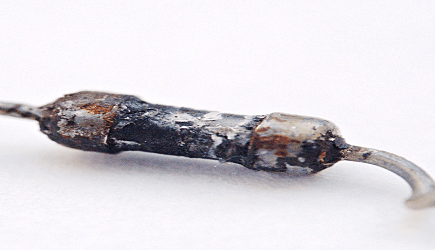See me, feel me, hear me
June 09, 2017
on
on

With so much electronic test equipment available that’s affordable and easy to use it’s easy to forget the fantastic ability of us e-engineers to interact with (faulty) electronics using just one’s senses and no equipment or apps at all.
I’m sure I am not alone in being able to smell out (literally) serious trouble in a circuit without access to a 6-digit ammeter with USB 3.0 and IoT connectivity. Even with the equipment switched off, certain parts that have run hot — and may be the cause of the trouble — produce a smell ever so light. Besides component failures, also be ready to identify your big fat design mistakes like the 1 ohm resistor where 1 k was required. Okay, it does help if the parts have signs of burning, scalding, glazing or micro explosion but the light smell alone should be strong enough especially if a part is in a well enclosed case which you open for the first time. Amps can be smelled, just as solder flux, hot pertinax, and dust.
And seen! A friend of mine with green fingers showed me his 10-hp cultivator that would not start although the 12-V 20-Ah battery was fully charged over winter time he said. On pressing the Start button I heard the engine crank over once, maybe twice, with no more than a one weak stroke audible in the exhaust. I saw a puff of grayish smoke rising up not from the exhaust but from one of the battery terminals and realized I was seeing starter motor amps being held up by a resistance that should not be there. No Keithley current clamp or milli-ohm meter was needed to determine bad connections between both battery poles and the round cable clamps, in fact the clamp bolts were not tightened at all and the battery poles lightly covered in organic matter. After cleaning the poles and the cable clamps with a steel brush and reassembling the lot in high-amp fashion, the machine started just fine.
Likewise, do not underestimate the sensory powers of your ears, especially for high pitched sounds, ticking and clicking noises. No one should need an oscilloscope to attack a nasty switch-mode power supply whining at two or more frequencies in the audible range, complete with intermodulation and temperature-controlled too! And yes the sound(s) that give away the clues to the fault may emanate from a capacitor, an inductor, a semiconductor, or even hardware like screws and fasteners!
The best sensors in the world are yours and free and to use, albeit with care and for a first diagnosis only. I’ve covered my “sensory abilities” for temperature, light and odors — which ones can you add? Press Add a comment below.
(Image Credit: Antilived through Wikimedia Commons)
I’m sure I am not alone in being able to smell out (literally) serious trouble in a circuit without access to a 6-digit ammeter with USB 3.0 and IoT connectivity. Even with the equipment switched off, certain parts that have run hot — and may be the cause of the trouble — produce a smell ever so light. Besides component failures, also be ready to identify your big fat design mistakes like the 1 ohm resistor where 1 k was required. Okay, it does help if the parts have signs of burning, scalding, glazing or micro explosion but the light smell alone should be strong enough especially if a part is in a well enclosed case which you open for the first time. Amps can be smelled, just as solder flux, hot pertinax, and dust.
And seen! A friend of mine with green fingers showed me his 10-hp cultivator that would not start although the 12-V 20-Ah battery was fully charged over winter time he said. On pressing the Start button I heard the engine crank over once, maybe twice, with no more than a one weak stroke audible in the exhaust. I saw a puff of grayish smoke rising up not from the exhaust but from one of the battery terminals and realized I was seeing starter motor amps being held up by a resistance that should not be there. No Keithley current clamp or milli-ohm meter was needed to determine bad connections between both battery poles and the round cable clamps, in fact the clamp bolts were not tightened at all and the battery poles lightly covered in organic matter. After cleaning the poles and the cable clamps with a steel brush and reassembling the lot in high-amp fashion, the machine started just fine.
Likewise, do not underestimate the sensory powers of your ears, especially for high pitched sounds, ticking and clicking noises. No one should need an oscilloscope to attack a nasty switch-mode power supply whining at two or more frequencies in the audible range, complete with intermodulation and temperature-controlled too! And yes the sound(s) that give away the clues to the fault may emanate from a capacitor, an inductor, a semiconductor, or even hardware like screws and fasteners!
The best sensors in the world are yours and free and to use, albeit with care and for a first diagnosis only. I’ve covered my “sensory abilities” for temperature, light and odors — which ones can you add? Press Add a comment below.
(Image Credit: Antilived through Wikimedia Commons)
Read full article
Hide full article


Discussion (2 comments)